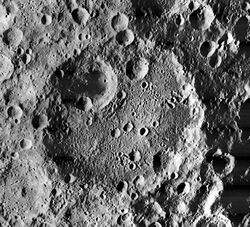Astronomy:Gagarin (crater)
 Lunar crater Gagarin seen by Lunar Orbiter 1 in 1966 | |
| Diameter | 265 km |
|---|---|
| Depth | 4.8 km |
| Colongitude | 215° at sunrise |
Gagarin is a large lunar impact crater that is located in the southern hemisphere on the far side of the Moon. To the southwest is the crater Pavlov and to the northeast lies Keeler. Closer to the rim are the craters Levi-Civita to the southwest, and Beijerinck to the north-northeast. Isaev lies entirely within the northwest rim of Gagarin. In contrast with the floor of Gagarin, Isaev has a floor with a somewhat low albedo.[citation needed]
Physical characteristics

The crater is named after Yuri Gagarin, the cosmonaut who was the first human in space and the first to orbit the Earth.[1] The six craters falling within the perimeter of Gagarin have also been named after pioneers of Russian aviation and astronautics, including Isaev, Grave, Balandin, Raspletin, Kosberg, and Andronov.[citation needed]
Gagarin has been heavily eroded by a long history of crater impacts. The worn rim forms a low, circular ridge around the somewhat bowl-shaped interior. The inner floor is covered by a multitude of crater impacts of various dimensions. Little if anything remains of a central ridge, if the crater ever possessed such a feature.[citation needed]
Satellite craters
By convention these features are identified on lunar maps by placing the letter on the side of the crater midpoint that is closest to Gagarin.[citation needed]
| Gagarin | Coordinates | Diameter, km |
|---|---|---|
| G | [ ⚑ ] 20°31′S 150°32′E / 20.51°S 150.54°E | 14 |
| M | [ ⚑ ] 23°31′S 149°10′E / 23.51°S 149.17°E | 18 |
| T | [ ⚑ ] 19°20′S 144°45′E / 19.33°S 144.75°E | 26 |
| Z | [ ⚑ ] 15°19′S 149°36′E / 15.31°S 149.60°E | 27 |
See also
- 1772 Gagarin, asteroid
References
- ↑ "Gagarin". Gazetteer of Planetary Nomenclature. USGS Astrogeology Science Center. https://planetarynames.wr.usgs.gov/Feature/2054?__fsk=1161336942.
Bibliography
- Andersson, L. E.; Whitaker, E. A. (1982). NASA Catalogue of Lunar Nomenclature. NASA RP-1097. p. 35. https://ntrs.nasa.gov/archive/nasa/casi.ntrs.nasa.gov/19830003761.pdf.
- Blue, Jennifer (July 25, 2007). "Gazetteer of Planetary Nomenclature". USGS. http://planetarynames.wr.usgs.gov/Feature/2054.
- Bussey, B.; Spudis, P. (2004). The Clementine Atlas of the Moon. New York: Cambridge University Press. ISBN 978-0-521-81528-4.
- Cocks, Elijah E.; Cocks, Josiah C. (1995). Who's Who on the Moon: A Biographical Dictionary of Lunar Nomenclature. Tudor Publishers. ISBN 978-0-936389-27-1. https://archive.org/details/isbn_9780936389271.
- McDowell, Jonathan (July 15, 2007). "Lunar Nomenclature". Jonathan's Space Report. http://host.planet4589.org/astro/lunar/.
- Menzel, D. H.; Minnaert, M.; Levin, B.; Dollfus, A.; Bell, B. (1971). "Report on Lunar Nomenclature by the Working Group of Commission 17 of the IAU". Space Science Reviews 12 (2): 136–186. doi:10.1007/BF00171763. Bibcode: 1971SSRv...12..136M.
- Moore, Patrick (2001). On the Moon. Sterling Publishing Co. ISBN 978-0-304-35469-6. https://archive.org/details/patrickmooreonmo00patr.
- Price, Fred W. (1988). The Moon Observer's Handbook. Cambridge University Press. ISBN 978-0-521-33500-3.
- Rükl, Antonín (1990). Atlas of the Moon. Kalmbach Books. ISBN 978-0-913135-17-4.
- Webb, Rev. T. W. (1962). Celestial Objects for Common Telescopes (6th revised ed.). Dover. ISBN 978-0-486-20917-3. https://archive.org/details/celestialobjects00webb.
- Whitaker, Ewen A. (2003). Mapping and Naming the Moon. Cambridge University Press. ISBN 978-0-521-54414-6. https://books.google.com/books?id=aV1i27jDYL8C.
- Wlasuk, Peter T. (2000). Observing the Moon. Springer. ISBN 978-1-85233-193-1.
External links
Lunar Topographic Orthophotomaps:
- Northwest Gagarin: LTO-102B2, Isaev
- Northeast Gagarin: LTO-103A1, Grave
- Southwest Gagarin: LTO-102B3, Andronov
- Southeast Gagarin: LTO-103A4, Raspletin
 |

